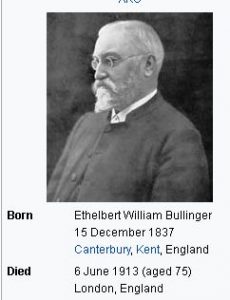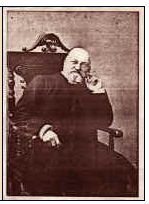Bullinger – Christian’s Standing, Object, and Hope is a short 3 Chapter work by Bullinger (Brethren) about the Christian life. Each of his three chapters correspondence to one of the topics in the title, The Christian’s Standing, The Christian’s Object, and The Christian’s Hope. (I, David Cox, have included 6 appendices on similar topics as is in this work.)
More Works on Salvation
[catlist name=”salvation” numberposts=15 pagination=yes instance=2]
Contents of Bullinger Christian’s Standing, Object, and Hope
- The Christian’s Standing.
- The Christian’s Object
- The Christian’s Hope.
Download
Download “Bullinger-E.-W.-Christians-Standing-Object-and-Hope.gbk_.twm”
Bullinger-E.-W.-Christians-Standing-Object-and-Hope.gbk_.twm – Downloaded 5 times – 24.00 KBEthelbert William Bullinger

Associate of King's College (15 December 1837 – 6 June 1913) was an Anglican clergyman, biblical scholar, and ultradispensationalist theologian. His family traced their ancestry back to Heinrich Bullinger, the Swiss Reformer. He was ordained as a priest in the Church of England in 1862. Bullinger's career in the Church of England spanned from 1861 to 1888. In the spring of 1867, at the age of 29, Bullinger became clerical secretary of the Trinitarian Bible Society, which he held, with rare lapses for illness in his later years, until his death, in 1913.
The society's accomplishments of TBS during his secretariat include the following:
- The completion and publication of a Hebrew version of the New Testament under a TBS contract with Christian David Ginsburg after the demise of Isaac Salkinson.
- The publication of Ginsburg's first edition of the Tanakh (Introduction to the Massoretico-Critical Edition of the Hebrew Bible).
- The formation (1885) of the Brittany Evangelical Mission Society under Pasteur LeCoat and translation of the Bible into Breton.
- The first-ever Protestant Portuguese Reference Bible.
- Distribution of Spanish Bibles in Spain after the 1868 Spanish Revolution.
He wrote four major works:
- A Critical Lexicon and Concordance to the English and Greek New Testament (1877) ISBN 0-8254-2096-2
- Number in Scripture (1894) ISBN 0-8254-2204-3
- Figures of Speech Used in the Bible (1898) ISBN 0-8010-0559-0
- Primary editor of The Companion Bible (published in 6 parts, 1909–1922) ISBN 0-8254-2177-2. It was completed after his death by his associates.
Those works and many others remain in print, as of 2007.
Bullingerism
Bullinger's views were often unique and sometimes controversial. He is so closely tied to what is now called "ultradispensationalism" that it is sometimes referred to as Bullingerism. Noted dispensationalist Harry A. Ironside (1876–1951) declared Bullingerism an "absolutely Satanic perversion of the truth." Bullingerism differed from mainstream dispensationalism on the beginning of the church. Mainstream dispensationalism holds that the Church began at Pentecost, as described early in the Acts of the Apostles. In stark contrast, Bullinger held that the Church, which the Apostle Paul revealed as the Body of Christ, began after the end of Acts, and was not revealed until the Prison Epistles of the Apostle Paul.
Other dispensationalists (often described as "mid-Acts" dispensationalists, Acts 9 or 13) hold that the Church, the Body of Christ, began at or shortly after Saul's conversion.
Bullinger described dispensations as divine "administrations" or "arrangements" under which God deals at distinct time periods and with distinct groups of people "on distinct principles, and the doctrine relating to each must be kept distinct." He emphasizes, "Nothing but confusion can arise from reading into one dispensation that which relates to another." He lists seven dispensations:
| Dispensational Scheme of Bullinger | ||||||
|---|---|---|---|---|---|---|
| Edenic state of Innocence | Period "without law" | Period under the Law | Period of Grace | Epoch of Judgment | Millennial Age | The Eternal State of Glory |
| Genesis 1-3 ended with the expulsion from Eden |
Genesis 4 to Exodus 19 ended with the flood and judgment on Babel |
Exodus 20 to Acts 28 ended at the rejection by Israel of the grace of God at the end of Acts |
Church History will end at the Day of the Lord |
Tribulation will end at the destruction of the Antichrist |
Rev 20:4-6 will end with the destruction of Satan |
Rev 20-22 will not end |
Other Bullinger views
Other than ultradispensationalism, Bullinger had many unique views. For example, Bullinger argued that the death of Jesus occurred on a Wednesday, not a Friday, after Pilate had condemned him at the previous midnight, and that Jesus was crucified on a single upright stake without crossbar with four, not just two, criminals and that this last view was supported by a group of five crosses of different origins (all with crossbar) in Brittany (put together in the 18th century).
Bullinger argued for mortality of the soul, the cessation of the soul between death and resurrection. He did not express any views concerning the final state of the lost, but many of his followers hold to annihilationism.
Bullinger was a supporter of the theory of the Gospel in the Stars, which states the constellations to be pre-Christian expressions of Christian doctrine. In his book Number in Scripture he expounded his belief in the gematria or numerology values of words in Scripture (names and terms), a concept of which the Encyclopædia Britannica says: "Numerology sheds light on the innermost workings of the human mind but very little on the rest of the universe." He strongly opposed the theory of evolution and held that Adam was created in 4004 BC. He was a member of the Universal Zetetic Society, a group dedicated to believing and promoting the idea that the earth is flat, and on 7 March 1905, he chaired a meeting in Exeter Hall, London, in which the flat earth theory was expounded.
Adapted from E.W. Bullinger - wikipedia.org (which see for footnotes on the above)
List of Bullinger's Works (non-downloadable)
Number in Scripture
Commentary on Revelation or, The Apocalypse
Word Studies on the Holy Spirit
The Witness of the Stars
How to Enjoy the Bible
The Book of Job, Including "The Oldest Lesson in the World"
The Church Epistles: Romans to Thessalonians
Figures of Speech Used in the Bible
Great Cloud of Witnesses
A Critical Lexicon and Concordance to the English and Greek New Testament
The Companion Bible
The Two Natures in the Child of God
The Foundations of Dispensational Truth
The Chief Musician Or, Studies in the Psalms, and Their Titles
Ten Sermons on the Second Advent
More theWord modules/Works by E.W. Bullinger
[catlist tags="ew-bullinger" numberposts=6 pagination=yes instance=100]
